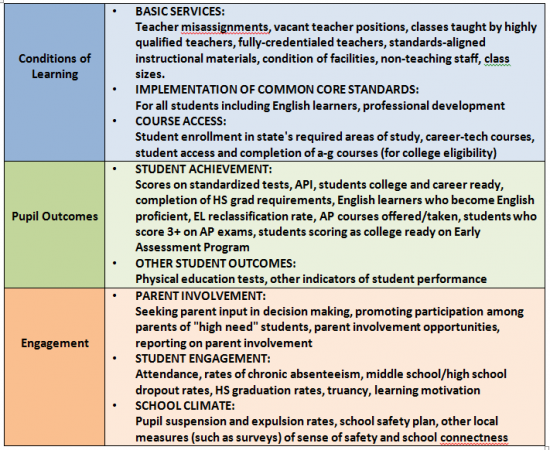Bye Bye API.

Now how are we going to measure school quality?
This post was contributed by Mary Perry*
How do you know if a school is good or not? For more than a decade, the de-facto answer to that question in California was test scores, and more specifically students’ scores on the state’s standardized tests. The Academic Performance Index (API) each school in the state received was based entirely on those scores. (See Ed100 Lesson 9.7.)
Test scores—all that counted, but not all that mattered.
The API was important. It largely determined which schools were eligible for honors, like being a “Distinguished School,” and which were tagged as low-performing.
It’s not that everyone believed that the API was the only way to measure school quality. The experts knew, for example, that the scores were more reflective of student backgrounds than of what was happening in classrooms. The tests could only shed light on limited skills and knowledge in a limited number of school subjects. But they were available, sanctioned by the state, and simple to understand and communicate. Realtors even used API scores to promote neighborhoods and to justify property values.
Will eight priorities replace one number?
Now it looks like the API will soon be obsolete, or at least a lot less significant. And standardized tests could be just one element in how we grade the quality of a school. [ed. note: this post was published in mid-September of 2014]
Replacing the API could and should be a good thing because we can stop pretending that one number tells us all we need to know about an organization and endeavor as complicated as a school. At the same time, parents and community members -- to say nothing of state officials -- want a reasonable way to compare and understand school performance. Hopefully state policymakers will replace the API with measures of school quality and effectiveness that are more meaningful but still easy to understand.
New measurements should be closely tied to California’s new funding and accountability system, which requires school districts to create Local Control Accountability Plans. (See Ed100 Lessons 7.8 and 7.10.) The new state law specifies that schools should be held accountable for eight broad "priorities" and, as the figure below indicates, for a wealth of specific "outcome measures" related to those priorities.
You can see that the API is just one of many measures of student achievement. The one-number score, or some new equivalent, could become part of a much broader report card for school districts and schools.
California's Eight State Priorities and Required Outcome Measures
A new state “rubric” for evaluating schools
Over the next year, the State Board of Education will be designing that report card, which should help districts and communities evaluate schools’ progress and identify areas for improvement. The official label for this work is the LCFF Evaluation Rubric.
Goals of the LCFF Evaluation Rubric:
More information about the rubric and its development is available here.
State leaders want your opinions about this. During the month of September, 2014, the State Board of Education is holding four meetings to gather public input. They will also take comments online from September 18 to 22; details here.
If you plan to participate you might want to spend a bit of time reading and thinking about how school success can and should be measured. A great place to start is Chapter 9 of Ed100.org.
How will performance be reported?
As the state’s Evaluation Rubric work gets underway, I keep wondering whether it will produce a measure of school and district quality that has meaning for the general public and for most of the folks actually working in schools.
Maybe it will be a bit like those old elementary report cards that give students one of three marks. That seems like a simple enough concept. Or maybe while the state’s evaluation and accountability process takes all eight state priorities into account, a single number measure will still be the most important thing—a bigger, brighter API.
Has our new accountability system already missed the boat?
I can’t help but worry that all of this new accountability work is just tinkering around the edges. Will it really help teachers prepare kids better for their futures?
If you want to join me in thinking more deeply about what kind of state accountability system could have that effect, I invite you to take a look at the report Fixing Our National Accountability System. The report’s author, Marc Tucker, is president of the National Center for Education and the Economy (NCEE). I consistently find him to be a thoughtful and well-informed voice in the discussion about how to improve our schools. At the risk of oversimplifying, his prescription is to create an accountability system that depends a lot less on test scores, instead creating other “very strong incentives for all teachers to work hard and constantly to improve their professional competence or get out of teaching.” His report is interesting reading.
*Mary L. Perry, an independent education consultant in California, helped with the writing and editing of Ed100. Her knowledge of education issues and policies, particularly school finance, was developed during the 18 years she served as deputy director of EdSource, as a local school board member, and as an active parent while her children attended public schools in San Jose.
Join the Discussion
- Should a measure of school quality be easy to communicate, like a grade point average, or should it reflect the many elements that go into an effective school, like a report card?
- What weight would you give each of the state’s eight priorities in an overall “grade” for a school or school district? (e.g. Should student achievement be given a lot of weight and basic services just a little?)
- In what ways might the highest priorities for school district accountability be different in your community than in others you’re familiar with?
Tags on this post
Accountability API Evaluation rubric LCAP LCFF Test scoresAll Tags
A-G requirements Absences Accountability Accreditation Achievement gap Administrators After school Algebra API Arts Assessment At-risk students Attendance Beacon links Bilingual education Bonds Brain Brown Act Budgets Bullying Burbank Business Career Carol Dweck Categorical funds Catholic schools Certification CHAMP Change Character Education Chart Charter schools Civics Class size CMOs Collective bargaining College Common core Community schools Contest Continuous Improvement Cost of education Counselors Creativity Crossword CSBA CTA Dashboard Data Dialogue District boundaries Districts Diversity Drawing DREAM Act Dyslexia EACH Early childhood Economic growth EdPrezi EdSource EdTech Education foundations Effort Election English learners Equity ESSA Ethnic studies Ethnic studies Evaluation rubric Expanded Learning Facilities Fake News Federal Federal policy Funding Gifted Graduation rates Grit Health Help Wanted History Home schools Homeless students Homework Hours of opportunity Humanities Independence Day Indignation Infrastructure Initiatives International Jargon Khan Academy Kindergarten LCAP LCFF Leaderboard Leadership Learning Litigation Lobbyists Local control Local funding Local governance Lottery Magnet schools Map Math Media Mental Health Mindfulness Mindset Myth Myths NAEP National comparisons NCLB Nutrition Pandemic Parcel taxes Parent Engagement Parent Leader Guide Parents peanut butter Pedagogy Pensions personalized Philanthropy PISA Planning Policy Politics population Poverty Preschool Prezi Private schools Prize Project-based learning Prop 13 Prop 98 Property taxes PTA Purpose of education puzzle Quality Race Rating Schools Reading Recruiting teachers Reform Religious education Religious schools Research Retaining teachers Rigor School board School choice School Climate School Closures Science Serrano vs Priest Sex Ed Site Map Sleep Social-emotional learning Song Special ed Spending SPSA Standards Strike STRS Student motivation Student voice Success Suicide Summer Superintendent Suspensions Talent Teacher pay Teacher shortage Teachers Technology Technology in education Template Test scores Tests Time in school Time on task Trump Undocumented Unions Universal education Vaccination Values Vaping Video Volunteering Volunteers Vote Vouchers Winners Year in ReviewSharing is caring!
Password Reset
Search all lesson and blog content here.
Login with Email
We will send your Login Link to your email
address. Click on the link and you will be
logged into Ed100. No more passwords to
remember!
















Questions & Comments
To comment or reply, please sign in .
vpeterson_2001 April 28, 2015 at 8:16 pm
Jeff Camp - Founder March 10, 2015 at 11:11 am